Exploring for the Future: new geomechanical data in frontier Australian basins
Adam Bailey A * , David Dewhurst B , Liuqi Wang A , Chris Carson A , Jade Anderson A , Grace Butcher A and Paul Henson AA
B

Adam H.E. Bailey is a Petroleum Geoscientist at Geoscience Australia, with expertise in petroleum geomechanics, structural geology and basin analysis. He graduated with a BSc (Hons) in 2012 and a PhD in 2016 from the Australian School of Petroleum at the University of Adelaide. Adam is currently part of the Onshore Energy Systems team at Geoscience Australia, where he is currently working on the flagship Exploring for the Future Program. |

Dave N. Dewhurst is a chief research scientist at CSIRO Energy in Perth. He holds a BSc (Hons) In Geology from the University of Sheffield (UK) and a PhD in Physics from the University of Newcastle Upon Tyne (UK). He previously held post-doctoral positions at the University of Birmingham (UK), the University of Newcastle upon Tyne (UK), the Institut Français du Pétrole near Paris and Imperial College, London, before moving to CSIRO in 1998. He works on mechanical and physical properties of rocks for petroleum exploration and development, specialising in overburden and gas shales, as well as reservoir and seal evaluation for geological storage of CO2 and other gases. |

Dr Liuqi Wang is a well analyst at Geoscience Australia working in the Minerals, Energy and Groundwater Division. He received his PhD in petroleum engineering and worked as a research fellow at the University of New South Wales before joining Geoscience Australia. His research interests include petrophysics, static and dynamic reservoir modelling, applied statistics and artificial intelligence. He is a member of PESA and EAGE. |

Chris Carson has worked in Antarctica, Canadian Arctic, Alaska, New Caledonia and northern and central Australia, specialising in metamorphic petrology, geochronology and structural geology. Joining Geoscience Australia in 2006, he dabbled in SHRIMP geochronology and, in 2017, joined the Onshore Energy program, working in the South Nicholson region of the NT. |

Jade Anderson completed a PhD at the University of Adelaide in the areas of metamorphic geology, geochronology and Proterozoic Australia tectonics in 2015. Jade now works as a Geoscientist in basin systems at Geoscience Australia. |

Grace Butcher (nee Westerman) is a Geologist at Geoscience Australia. She graduated with a BSc (Hons) in 2010 from the School of Earth and Environment at the University of Leeds. Working with the Onshore Energy Systems team at Geoscience Australia. Grace is currently working on the flagship Exploring for the Future Program in Northern Australia. |

Paul A. Henson graduated from the University of Tasmania and is currently the Director of the Onshore Energy Systems section at Geoscience Australia. He has extensive experience in the minerals sector working on mineral systems in Proterozoic and Archaean terranes. Since 2010, he has led the Australian Government’s onshore carbon storage program, undertaking deep onshore drilling and seismic acquisition programs in collaboration with the states and industry. He now manages the EFTF Energy program, leading a team of researchers to acquire new pre-competitive geoscientific data to improve our understanding of the oil and gas potential of Australian onshore basins. |
Abstract
Led by Geoscience Australia, Exploring for the Future (EFTF) is a A$225 million Australian Government program dedicated to exploring Australia’s resource potential and boosting investment. The EFTF program energy component aimed to attract industry investment by delivering a suite of new precompetitive geoscience data in prospective Australian sedimentary basins. Through EFTF, Geoscience Australia has acquired significant amounts of new geomechanical data from underexplored onshore sedimentary basins with identified hydrocarbon prospectivity, from both legacy and newly acquired samples. These data were acquired to build a better understanding of basin sediment rock properties, particularly looking at the reservoir and seal potential of postulated unconventional and conventional targets. Four major datasets are presented herein, representing prospective intervals from the Paleozoic Canning Basin of Western Australia, the Neoproterozoic-Paleozoic Officer Basin of South Australia and Western Australia, the Paleo-Mesoproterozoic South Nicholson region of the Northern Territory and northwest Queensland, and the Paleo-Mesoproterozoic Birrindudu Basin of the Northern Territory and Western Australia. Additionally, the Paleo-Mesoproterozoic McArthur Basin of the Northern Territory is represented by a small number of analyses. Tests include unconfined compressive strength tests, laboratory ultrasonic measurements, single and multi-stage triaxial tests and Brazilian tensile strength tests. These datasets are a precompetitive resource that can facilitate investment decisions in frontier regions, helping to identify elements of conventional and unconventional hydrocarbon systems as well as providing essential data to assess geological storage opportunities.
Keywords: Birrindudu Basin, Canning Basin, Exploring for the Future, frontier basins, geological storage, geomechanics, Greater McArthur Basin, Officer Basin, Proterozoic shales, South Nicholson region.
Introduction
Exploring for the Future (EFTF) is a A$225 million Australian Government program dedicated to stimulating industry to ensure a sustainable, long-term future for Australia through an improved understanding of the nation’s minerals, energy and groundwater resource potential. The energy component of the program aims to attract industry investment by delivering a suite of new precompetitive geoscience data and knowledge of the hydrocarbon prospectivity of Australian sedimentary basins. Although the EFTF program is ending in 2024, the significant precompetitive geological datasets that were acquired under the program provide the geological foundation that will continue to deliver benefits well into the coming decades.
Under EFTF, new geomechanical work has been undertaken, including stress modelling (e.g. Bailey et al. 2019, 2021b, 2022a), shale brittleness studies (e.g. Jarrett et al. 2020a; Bailey et al. 2022b) and the acquisition of extensive new rock property data through a program of laboratory analysis of both newly acquired and legacy rock samples in several frontier regions (e.g. Jarrett et al. 2020a; Bailey et al. 2021c, 2022c). These data form a foundational dataset that is integral to understanding both conventional and unconventional petroleum systems, as well as carbon storage and sedimentary geothermal systems in a modern exploration setting as progress is made towards a net zero energy future. Further potential applications for exploration and storage of hydrogen or waste products are likely.
Understanding rock properties and in-situ stresses is essential for assessing low permeability unconventional systems, such as shale gas and tight sandstone plays, as these factors have a primary control over fluid flow pathways, particularly the generation and propagation of hydraulic fractures (Bell 1996; Hillis and Reynolds 2003; Zoback 2007). While fluid extraction from low permeability reservoirs requires hydraulic stimulation to create permeability pathways to enable the flow of fluid from the reservoir to the well (Bell and Babcock 1986; Bell 1990), the opposite is true when injecting fluids such as carbon dioxide (CO2) or hydrogen for short- or long-term storage (Berest 2011; Tenthorey et al. 2022). When injecting into reservoirs, pore fluid pressure is increased and this can reduce the strength of rocks and faults to the point of inducing brittle failure, potentially resulting in induced seismicity and the creation of leakage pathways via hydraulic fracturing of sealing formations (Holford et al. 2024). Additionally, hydraulic stimulation can be required for the creation of fluid pathways in hot sedimentary aquifer-type geothermal projects (Johnson et al. 2010) and an understanding of local rock properties and in-situ stress is crucial for underground storage of nuclear waste products (Sharma et al. 2017). The orientations and magnitudes of present-day stresses also have implications for borehole stability, enhanced oil recovery and fault reactivation (Horn 1991; Addis et al. 1993; Hillis and Williams 1993a, 1993b; Mildren et al. 1994; Hillis and Reynolds 2003).
Building a detailed understanding of geomechanical rock properties allows for interpretations of conventional and unconventional hydrocarbon prospectivity in frontier provinces, as well as suitability assessments for potential geological storage sites. Analysis and interpretation of these empirical datasets establish not only how likely it is, and in what manner, that rocks will deform, but also how suitable those rocks are to serve as reservoirs or seals (Zoback 2007).
Elastic rock properties such as Poisson’s ratio and Young’s modulus are required for modelling stress, strain and deformation. There are two main ways to measure key elastic properties: the static method whereby the deformation induced in a material by the application of a known force is measured; and the dynamic method whereby ultrasonic body wave velocities are measured, with the elastic property then calculated through empirically established relationships (Ciccotti and Mulargia 2004). Typically, static and dynamic properties differ due to the difference in inelastic effects (e.g. Ciccotti and Mulargia 2004); Davarpanah et al. (2020) attribute the discrepancies between dynamic and static elastic moduli to microcracks and pores. Brotons et al. (2016) note that the ratio between elastic moduli tends to decrease in very stiff and compact rocks, and increases as stiffness and compactness decrease. Generally, static moduli are likely to be slightly lower than dynamic moduli; however, variations of up to an order of magnitude are not uncommon (Ciccotti and Mulargia 2004). One exception is for Poisson’s ratio. Generally, the difference between static and dynamic Poisson’s ratio (vstat and vdyn, respectively) is very small and so it is often not considered, as there is no direct relationship between dynamic and static Poisson’s ratio.
Accurate characterisation of static geomechanical rock properties through laboratory testing is essential. In the modern exploration environment, these datasets are a resource that can inform investment decisions and exploration strategies in prospective frontier regions. The availability of laboratory-derived rock property values such as rock strengths and elastic moduli allows for the construction of detailed mechanical earth models, enables the designing of drilling programs and placing wells (mitigating drilling risk and ensuring wellbore stability) and facilitates the prediction of fracture propagation. Understanding these properties allows for regions with favourable geomechanical conditions to be identified, avoiding deformation of reservoirs and seals – key risks in the successful geological storage of CO2 or hydrogen (Tenthorey et al. 2022; Holford et al. 2024). A significant issue is that these data are typically spatially limited, particularly in frontier regions, and mainly consist of basic crustal stress orientation measurements, rather than a full 3D description of the stress tensor and related geomechanical rock properties. Hence, providing baseline geomechanical data in frontier basins is essential as legacy data coverage can often be inadequate for making investment decisions, particularly where unconventional or geological storage plays are a primary exploration target. The data delivered through EFTF by Geoscience Australia enhance our understanding of underexplored, prospective regions throughout Australia and lower the barrier to entry for further greenfield exploration.
Regions of interest
New data have been acquired within several regions of interest during the lifetime of the EFTF program (Fig. 1):
The Paleo-Mesoproterozoic South Nicholson region of the Northern Territory and northwest Queensland;
The Paleozoic Canning Basin of Western Australia;
The Neoproterozoic-Paleozoic Officer Basin of South Australia and Western Australia;
The Paleo-Mesoproterozoic Birrindudu Basin of the Northern Territory and Western Australia.
Map figure showing the location of the sampled drill holes in this study, as well as the sedimentary basins in which those holes were drilled. Deep crustal reflection seismic lines acquired during the Exploring for the Future (EFTF) program are also shown.
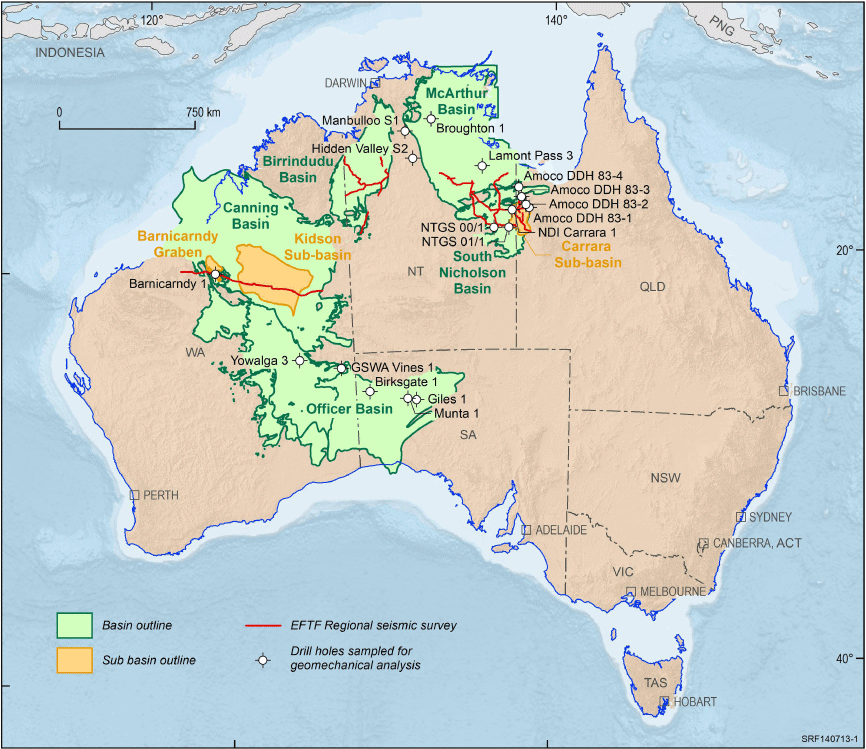
Additionally, the Paleo-Mesoproterozoic McArthur Basin of the Northern Territory is represented by a small number of analyses that were opportunistically sampled to provide an insight into prospective intervals and to potentially allow for controlled extrapolations of rock properties between the Proterozoic units of the South Nicholson and Birrindudu regions and genetically related Greater McArthur Basin intervals.
Methods and results
Analyses that were undertaken vary by region, primarily due to factors such as the availability of suitable sample material and accessibility of that material. For example, Barnicarndy 1 and NDI Carrara 1 samples were sampled remotely due to COVID-19 related travel restrictions, and Birrindudu Basin sampling was restricted by the fact that the majority of available material is from small-gauge, shallow minerals-industry drill cores. Sampling in all locations was also heavily affected by core condition, particularly for older cores that have been in storage for significant lengths of time.
Broadly speaking, rock property analysis targeted reservoir-seal pairs as much as practical given the above-described constraints, characterising mechanical properties using the following techniques:
Unconfined compressive strength (UCS) parameters;
Stress–strain–time curves for UCS experiments;
Tensile strength characteristics;
Static elastic properties, Young’s modulus (E) and Poisson’s ratio (v);
Dynamic elastic properties, velocity, Vp/Vs ratio, Young’s, bulk and shear moduli plus Poisson’s ratio.
Where suitable sample materials for analysis were available and further data were desired, multi-stage triaxial tests were undertaken. Where sample material was limited and suitably sized core plugs could not be recovered, attempts were made to acquire discs suitable for Brazilian tensile strength tests. A subset of high-quality samples from intervals of interest (e.g. gas-rich black shales and potential tight sand reservoirs) were subjected to multi-stage triaxial tests to provide an additional comprehensive datatset.
Reports detailing the results of these analyses in each studied region have been published via Geoscience Australia’s catalogue (eCat 2023) as soon as feasible following provision of final data. Additionally, these data are currently being added to the Geoscience Australia portal (www.portal.ga.gov.au) where they can be easily accessed and downloaded, alongside numerous other precompetitive datasets.
Results by region
The South Nicholson region (Fig. 1) is an informal geographical region previously described to include the underexplored area south of the Murphy Province in Northwest Queensland and the Northern Territory, encompassing the sedimentary packages of the South Nicholson Basin, Lawn Hill Platform and Isa Superbasin equivalents of the Mount Isa Province (Jarrett et al. 2020a). Two large-scale regional reflection seismic surveys (Geoscience Australia 2023a, 2023b) and a recently drilled deep stratigraphic drillhole have been completed through EFTF in partnership with the Northern Territory Geological Survey (NTGS). An extensive, complementary, range of precompetitive datasets were also acquired (Geoscience Australia 2023c) and include geomechanical rock property data from 14 core samples of Paleo- to Mesoproterozoic section from five legacy stratigraphic drill holes. Samples were subjected to unconfined compressive rock strength tests, laboratory ultrasonic measurements and characterised via X-ray computerised tomography scanning. Background, methods and results are summarised in Jarret et al. (2020a). For all samples, cylindrical core plugs approximately 25 mm in diameter and 50 mm in length were prepared normal to bedding (vertical).
A visual summary of geomechanical testing results is presented in Fig. 2, with well locations on Fig. 1.
Results of compressive testing from the South Nicholson region for (a) unconfined compressive strength (UCS), (b) Young’s modulus and (c) Poisson’s ratio. See Jarrett et al. (2020a) for details.
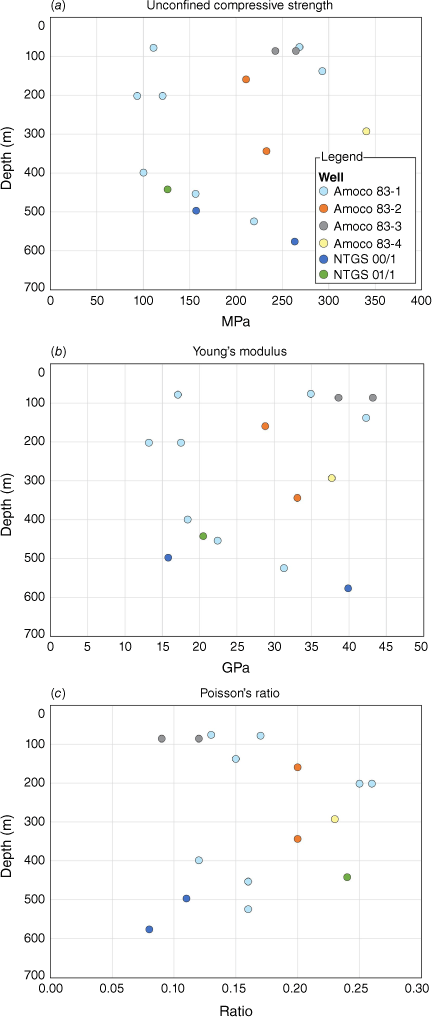
As part of Geoscience Australia’s acquisition of new pre-competitive data in the South Nicholson region, NDI Carrara 1 (Fig. 1) was drilled in 2020 in partnership with the NTGS and MinEx CRC to provide lithology control in support of new precompetitive data in the South Nicholson region. NDI Carrara 1 is the first stratigraphic test of the recently described Carrara Sub-basin (Carr et al. 2020), a depocentre located in the South Nicholson region (Fig. 1). The drill hole reached a total depth of 1751 m and penetrated a 630 m succession of Cambrian-aged Georgina Basin carbonate and siliciclastic rocks that unconformably overly a thick succession of Proterozoic age siliciclastic and carbonate-rich sediments. Drilled on the western flank of the Carrara Sub-basin, NDI Carrara 1 was continuously cored from 283 m to total depth at 1751 m and was logged with a broad suite of wireline logging tools (Bailey et al. 2021a; Grosjean et al. 2022; Wang et al. 2023). Recent SHRIMP zircon U-Pb geochronology results demonstrate that the Proterozoic interval intersected in the drill hole is stratigraphically equivalent to the middle to upper Lawn Hill Formation of the northern Lawn Hill Platform, host to the world-class Pb-Zn Century deposit as well as the Egilabria shale gas play in northwestern Queensland (Carson et al. 2022). Eighteen samples from NDI Carrara 1 were selected for geomechanical testing, from which 36 plugs were extracted for analysis. These samples were subjected to UCS tests, repeat single-stage triaxial testing and laboratory ultrasonic measurements. Petrophysical properties were also characterised via X-ray computerised tomography scanning, bulk- and clay-fraction X-ray diffraction (XRD), mercury injection capillary pressure (MICP) analysis, grain density and porosity–permeability analysis of 32 samples which overlap with the geomechanical samples (Bailey et al. 2021c). Cylindrical core plugs approximately 25 mm in diameter and 50 mm in length were prepared normal to the core axis, with the aim of being normal to bedding (vertical) for UCS and triaxial testing. However, due to inclined bedding and the need to minimise damage to the core, these samples were plugged with inclined bedding of 15–60°. Several plugs were also prepared parallel to bedding for UCS testing.
A visual summary of geomechanical testing results is presented in Fig. 3, with the NDI Carrara 1 well location on Fig. 1.
Results of compressive testing from NDI Carrara 1 for (a) unconfined compressive strength (UCS), (b) Young’s modulus and (c) Poisson’s ratio. See Bailey et al. (2022c) for details.
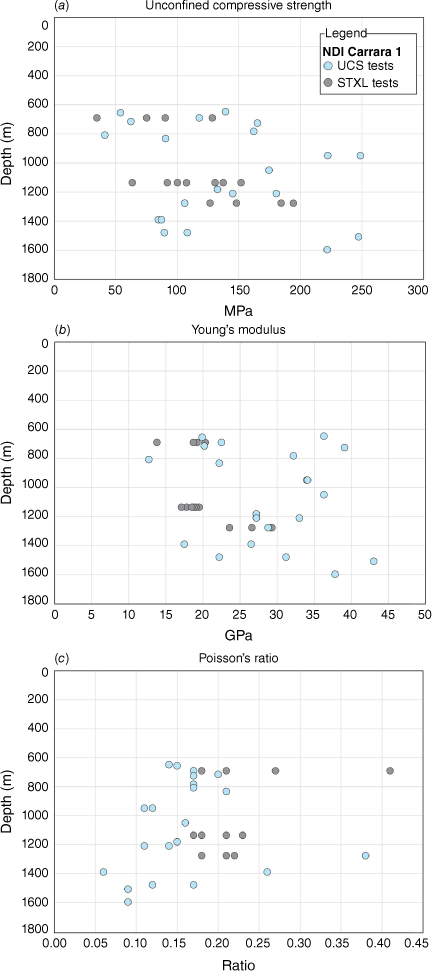
The Kidson Sub-basin of Western Australia’s Canning Basin (Fig. 1) is a large, underexplored depocentre that possibly hosts a continuation of proven Canning Basin petroleum systems (Carr et al. 2020; Southby et al. 2020). Significant new regional deep-crustal 2D seismic reflection data, jointly funded by EFTF and the Western Australian State Government Exploration Incentive Scheme, were acquired over the Kidson Sub-basin in 2018. The deep stratigraphic drill hole Barnicarndy 1 was drilled in 2019 in partnership with the Geological Survey of Western Australia. The drill hole was located in the Barnicarndy Graben of the Canning Basin, 67 km west of Telfer, to provide stratigraphic control for the Kidson Sub-basin seismic line and reached a total depth of 2680.5 m RT. Ditch cuttings were recovered from the surface to 580 m depth, with continuous core recovered from 580 m to TD. A Carboniferous to Permian fluvial clastic succession, including glacial diamictite, was interpreted to unconformably overlie a thick Ordovician sandstone dominated succession (Bailey et al. 2021b). The drill hole terminated in low-grade Neoproterozoic metasediments. Three potential reservoir-seal pairs identified in this core were sampled for geomechanical and petrophysical analyses, with sampling dependent on core integrity. These samples were subjected to UCS tests and laboratory ultrasonic measurements. Petrophysical properties were also characterised via X-ray computerised tomography scanning, MICP analysis, grain density, porosity–permeability analysis and broad-ion-beam milling and scanning electron microscopy (CSIRO 2020; Jarrett et al. 2020b). Cylindrical core plugs approximately 25 mm in diameter and 50 mm in length were prepared normal to the core axis, with the aim of being normal to bedding (vertical) for UCS testing.
A visual summary of geomechanical testing results is presented in Fig. 4, with the Barnicarndy 1 well location on Fig. 1.
Results of compressive testing from the Canning Basin drill hole Barnicarndy 1 for (a) unconfined compressive strength (UCS, MPa), (b) Poisson’s ratio (unitless ratio) and (c) Young’s modulus (GPa). Note, multiple x axes are plotted on this graph. Further details are outlined in Bailey et al. (2021c).
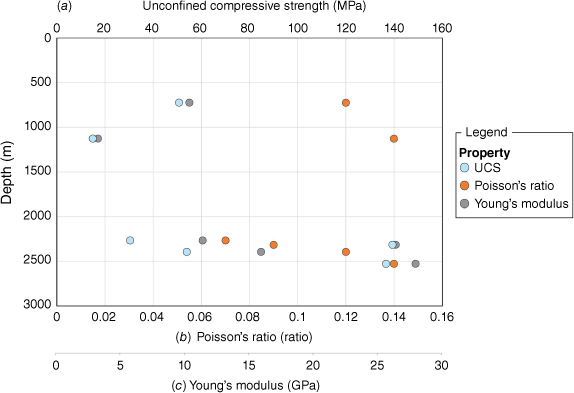
Despite numerous demonstrated oil and gas shows, the Officer Basin of South Australia and Western Australia (Fig. 1) remains a frontier basin for energy exploration with significant uncertainties due to poor data availability. Under the EFTF Officer-Musgrave-Birrindudu Project (Geoscience Australia 2023d), Geoscience Australia acquired new geomechanical rock property data from 40 core samples in five legacy stratigraphic and petroleum exploration drill holes that intersected Paleozoic and Neoproterozoic aged intervals. These samples were subjected to unconfined compressive rock strength tests, Brazilian tensile strength tests and laboratory ultrasonic measurements. Petrophysical properties were also characterised via X-ray computerised tomography scanning, grain density and porosity–permeability analysis. Background, methods and results are summarised in Bailey et al. (2021c). Cylindrical core plugs approximately 25 mm in diameter and 50 mm in length were prepared normal to bedding for UCS testing, and where a core was unable to yield a plug suitable for UCS testing, an approximately 25 mm by 10–15 mm disc was extracted for Brazilian tensile strength testing.
A visual summary of geomechanical testing results is presented in Fig. 5, with well locations on Fig. 1.
Results of compressive testing from the Officer Basin for (a) unconfined compressive strength (UCS), (b) tensile rock strength, (c) Poisson’s ratio and (d) Young’s modulus. Note, Brazilian tensile strength tests were only carried out on a subset of the samples (see Bailey et al. 2021a). Further details are outlined in Bailey et al. (2021a).
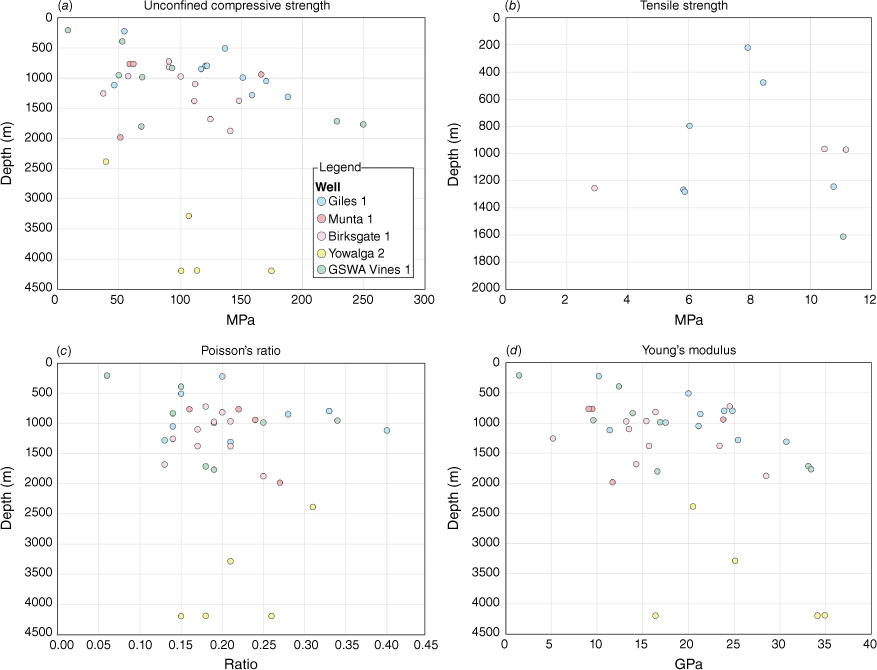
The Paleo- to Mesoproterozoic Birrindudu Basin (e.g. Dunster and Ahmad 2013) of the northwestern Northern Territory and northeastern Western Australia (Fig. 1) is an underexplored frontier basin that hosts strata of similar age to the prospective McArthur Basin, South Nicholson region and Mount Isa Province. Proterozoic strata in the western McArthur Basin (west of the Daly Waters Fault Zone) can be interpreted to correlate with the eastern Birrindudu Basin (Hoffman 2014; Williams 2019). As part of EFTF, Geoscience Australia in collaboration with the NTGS completed acquisition of the Northwest Northern Territory Seismic Survey in 2023, imaging the Birrindudu Basin and the Tanami Region. This regional reflection seismic survey ties existing industry surveys to the east with seismic data in the Tanami Region to the south. In support of this significant new dataset, Geoscience Australia acquired new geomechanical and petrophysical data from 22 samples from four legacy exploration drill holes in the Birrindudu Basin and surrounding regions: Manbulloo S1, Hidden Valley S2, Lamont Pass 3 and Broughton 1 (Fig. 1). Lamont Pass 3 and Broughton 1 are interpreted to intersect units belonging to the McArthur Basin (Armour Energy 2014; Rawlings 2015). Drill holes Manbulloo S1 and Hidden Valley S2 are located outside the provisional Birrindudu Basin outline (Fig. 1) and the current McArthur Basin outline of Raymond et al. (2018), but intersect units that are interpreted as equivalent to units within the McArthur and Birrindudu basins (Pangaea Resources 2015a, 2015b). These samples were subjected to UCS tests and one depth was selected for repeat single-stage triaxial testing. Unfortunately, laboratory ultrasonic measurements were not obtained and, hence, no dynamic elastic properties could be calculated as appropriate sonic logs were not acquired in these drill holes either. Petrophysical properties were characterised via X-ray computerised tomography scanning, bulk-fraction XRD, grain density and porosity–permeability analysis. Background, methods and results are summarised in Anderson et al. (2024). Cylindrical core plugs approximately 25 mm in diameter and 50 mm in length were prepared normal to bedding for UCS testing, and where a core was unable to yield a plug suitable for UCS testing. No Brazilian tensile strength tests were undertaken.
A visual summary of geomechanical testing results is presented in Fig. 6, with well locations on Fig. 1.
Results of compressive testing from the Birrindudu and Greater McArthur Basin for (a) unconfined compressive strength (UCS), (b) Young’s modulus and (c) Poisson’s ratio. See Bailey et al. (2022c) for details.
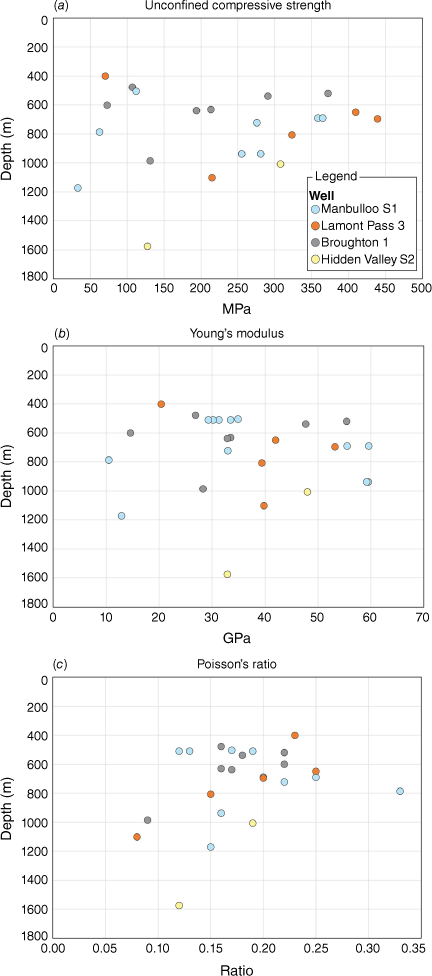
Discussion
While there are numerous applications for the data summarised herein, given the frontier nature of the prospective regions studied, the primary application is to establish prospectivity for unconventional energy resources and potential for geological storage. Primarily, this is an issue or whether rock failure is desired (e.g. for resource extraction) or not (e.g. for geological storage).
Static data are expensive and so often rarely acquired, particularly in frontier areas. However, wireline sonic data are often obtained while drilling and provide for dynamically calculated elastic properties. Where this data coverage overlaps with static measurements, or where ultrasonic measurements have been taken during rock testing, dynamic to static conversions can be established and these enable estimates of static values from wireline logging data, which can then be used for modelling in-situ stresses and rock failure.
In the four regional datasets presented herein, ultrasonic data were acquired in three. Unfortunately, these data were not available for the Birrindudu Basin and greater McArthur Basin (Figs 1, 6) and these wells also do not feature suitable sonic logs. Where these data are available, crossplots of laboratory measured (static) and ultrasonic derived (dynamic) Young’s modulus and Poisson’s ratio can illustrate the relationships between these parameters.
In the Officer Basin, a clear relationship between static and dynamic Young’s modulus (Estat and Edyn, respectively) measurements is evident, with coefficients of determination (R2 values, Fig. 7g) of 0.7858 and 0.7764 for shales and sandstones, respectively (Fig. 7g). Bailey et al. (2022d) present lithology specific conversions and demonstrate that, from the analysed samples, a generic conversion of Estat = 0.6 × Edyn provides an effective relationship for estimating Young’s modulus in the Officer Basin. As expected, comparison of vstat and vdyn shows no meaningful relationship, with R2 values of 0.0519 and 0.0014 for shales and sandstones, respectively (Fig. 7h).
Crossplots of laboratory measured (static) and calculated values (dynamic) Young’s modulus and Poisson’s ratio by simplified lithology, presented by study area, from top to bottom: The South Nicholson region (a, b), the deep stratigraphic drillhole NDI Carrara 1 (c, d), the deep stratigraphic drillhole Barnicarndy 1 (e, f), and the Officer Basin (g, h). ‘Sandstone’ includes all sandstones and siltstones, ‘Shale’ includes all shales, mudstones and claystones, and ‘Carbonates’ includes any predominantly carbonate rock. Dynamic values of Young’s modulus and Poisson’s ratio are calculated from benchtop ultrasonic measurements. Further details on testing and results are presented in methods and results.
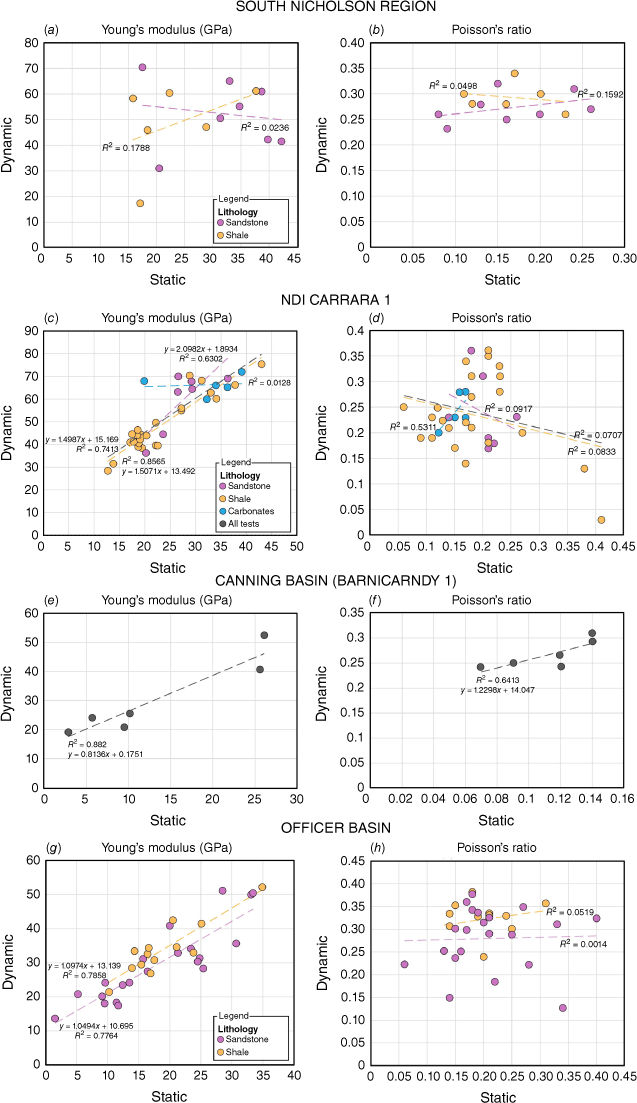
However, in the South Nicholson region data (excluding NDI Carrara 1 data), there is no meaningful correlation between Estat and Edyn, with R2 values of 0.0236 and 0.1788 for shales and sandstones, respectively (Fig. 7a). While analysing samples from the drill hole Amoco 83-1, for which the largest numbers of samples are available, meaningful correlations between Estat and Edyn are observed, with R2 values of 0.7912 and 0.9142 for shales and sandstones, respectively. However, these are still from a small sample set and should be considered with caution. One potential explanation for the poor correlations observed across the larger dataset is that while all best efforts were made in sampling, samples were drawn from limited material which include multiple lithologies (e.g. interbedded sandstones and siltstones). It is also worth remembering that while many samples from the South Nicholson region are from laterally chrono-stratigraphically equivalent supersequences, these supersequences contain numerous lithologies and facies variations and their diagenetic histories can vary significantly. Comparing vstat and vdyn shows no meaningful relationship, with R2 values of 0.0498 and 0.1592 for shales and sandstones, respectively (Fig. 7b).
The deep stratigraphic drillhole NDI Carrara 1 has been exceptionally well sampled. Hence, it is worth considering the samples from this drillhole separately to the other South Nicholson region analyses addressed above. The NDI Carrara 1 testing data show clear meaningful correlations between Estat and Edyn, with an R2 of 0.7413 for all samples, regardless of lithology or test type (Fig. 7c). When this is broken down by lithology (and incorporating results from both UCS and triaxial analyses) R2 values of 0.8565, 0.6302 and 0.0128 for shales, sandstones (including siltstones) and carbonates are calculated, respectively (Fig. 7c). The lower correlation between Estat and Edyn in sandstone intervals is likely due to the low number of samples analysed, combined with the fact that this category also includes siltstones and turbiditic intervals (Bailey et al. 2022). Carbonates show no correlation between Estat and Edyn and this is likely due to both low sample numbers and the fact that the classification of ‘carbonate’ is broad, and in this instance includes calc-mudstone, calc-siltstone, marl and micrite. While lithology specific conversions of Estat and Edyn are calculated, broadly, a conversion of Estat = 0.667 × (Edyn + 15) should provide relatively reliable estimates of Estat within NDI Carrara 1 and may be of use to extrapolate values in the broader Carrara Sub-basin. However, for simplicity, an estimation of Estat = 0.447Edyn provides as good a correlation to the measured static data as the above conversion once the carbonate data are removed, and this is only slightly behind the correlation obtained when using the lithology specific relationships (Fig. 8). Comparing vstat and vdyn showed no meaningful relationship, with R2 of 0.0707 calculated for all samples, and values of 0.0833 and 0.0917 for shales and sandstones, respectively (Fig. 7d). However, an R2 value of 0.5311 is calculated for carbonates (Fig. 7d) that, although from a low number of lithologically diverse samples, may warrant further investigation to understand relationships between these properties in the Carrara Sub-basin.
Crossplot of measured static Young’s modulus values and values converted from dynamic values of Young’s modulus in NDI Carrara 1, utilising three methods: (1) lithology specific conversions derived for shale and sandstones (purple), (2) a conversion utilising all values measured in the drill hole and (3) an estimation (green) as discussed in text. Trendlines show the R2 value for each method in colours matching the datapoints.
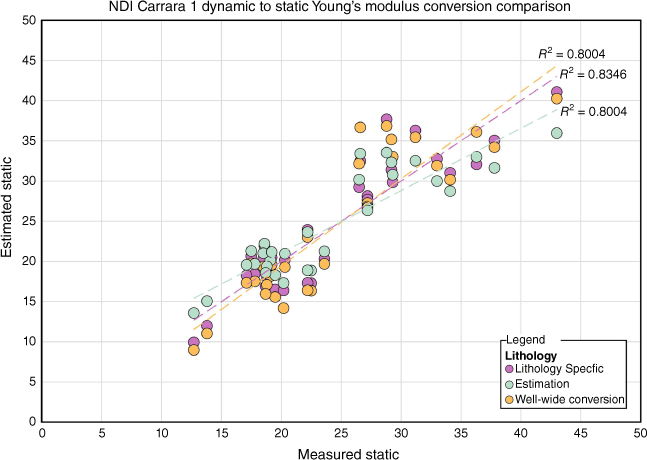
The Canning Basin dataset is incredibly spatially limited in that it consists of six samples from a point location in the deep stratigraphic drill hole Barnicarndy 1 (Fig. 1). These samples consist of three sandstones, two shales and one diamictite and, hence, do not provide enough lithology specific data to construct meaningful relationships. However, on a well-scale, a meaningful correlation between Estat and Edyn is observed, with R2 of 0.8820 (Fig. 7e). This relationship yields a conversion of Estat = 0.813 × Edyn − 14 that, however, should obviously be considered with caution given the small number of samples this is based on and the lithological variation within those samples. Unlike other datasets, a relationship is observed between vstat and vdyn, with R2 of 0.6413 (Fig. 7f). However, it must be again noted that typically no relationship exists between vstat and vdyn, and that this correlation is from a small, lithologically varied sample.
Primarily, samples were selected as being representative of conventional and unconventional reservoirs and seals, although in some areas this was dependent on the availability and accessibility of samples. While reliable relationships between static and dynamic properties could not be established for the South Nicholson region samples, these are demonstrated to have high Young’s moduli, high UCS and low Poisson’s ratios (Jarrett et al. 2020a; Bailey et al. 2021a). Additionally, the analysed shales are potentially brittle due to their low Poisson’s ratio and zero load-bearing ability after failure (Fig. 1); all rocks tested are hard and strong and, hence, would require significant stresses to deform (Bailey et al. 2021a). Similar characteristics are observed in the analysed NDI Carrara 1 samples, which were mainly shales. Testing of these shales also demonstrates high Young’s moduli, high UCS and low Poisson’s ratios.
Triaxial tests on two shales (690 and 1136 m) and a tight sandstone (1276 m) from NDI Carrara 1 demonstrate results broadly consistent with other low porosity, high density rocks. Such analyses are useful as, among other things, they allow for the creation of failure envelopes for the investigated lithologies. Mohr–Coloumb plots constructed from the results from the NDI Carrara 1 analyses demonstrate that significant changes in effective stress would be necessary to cause failure in the analysed intervals. This is consistent with the high recorded values of UCS and Young’s modulus throughout the NDI Carrara 1, and indeed broader South Nicholson region, testing and provides further support to the interpretation of these rocks as being hard and strong. An additional takeaway from the triaxial analysis of the shale samples is that while these rocks are strong, they are also brittle. Hence, while initiating failure in these intervals would likely require significant changes in effective stresses, once initiated, fractures should propagate through these intervals as they are brittle. Bailey et al. (2022a) demonstrates that interpreted stress regimes in these intervals are conducive to the vertical propagation of fractures and that lithology influenced stress variations may contain the vertical spread of fractures to within target intervals.
Results of UCS testing on the Canning Basin samples from Barnicarndy 1 demonstrate very low Poisson’s ratios which, again, imply that these rocks are likely to be brittle. Shales, in particular, demonstrate brittle behaviour – stress–strain curves highlight pronounced peak strengths, followed by fracturing and a resultant load-bearing capacity of zero (Jarrett et al. 2020c; Bailey et al. 2021a). Measured UCS values are typical for lithology and porosity, although some may be slightly over-estimated due to the mode of failure during testing (Bailey et al. 2021a). The uppermost sandstone (1127.1 mRT) is porous and permeable (Jarrett et al. 2020b) and, hence, has lower strength than deeper sandstones which are tighter, stronger and have higher Young’s moduli; implying that they would require more stress to deform than the shallow sandstone.
In the Birrindudu Basin analysis, triaxial tests were undertaken on one tight sandstone sample from 510.5 m depth in Manbulloo S1. Unfortunately, due to heterogeneity caused by the presence of fine-scale cemented veins, variability in failure strength with confining pressure was observed. While this is likely due to the veins causing heterogeneities within the stress field in individual core plugs, it also means that the results from the testing did not yield reliable Mohr circles, as the results are scattered and do not fall within the expected order of increasing strength and stiffness with increasing confining pressure. The UCS testing results demonstrate similar characteristics to those observed in the South Nicholson region, with high Young’s moduli, high UCS and low Poisson’s ratios (Fig. 6).
Summary and conclusions
The EFTF program has delivered significant volumes of new precompetitive geoscience data in frontier Australian onshore sedimentary basins, including new geomechanical data obtained through laboratory analysis of legacy and newly acquired samples. Material from four regions was analysed, with an emphasis placed on sampling units with potential as reservoirs and/or seals within postulated unconventional and conventional systems.
Primarily, testing consisted of UCS tests that provide static values of major elastic and strength properties, with most samples also subjected to laboratory ultrasonic measurements from which dynamic elastic rock properties can be calculated. In addition, single and multi-stage triaxial tests and Brazilian tensile strength tests were undertaken where samples were available and suitable. The acquisition of both static and dynamic elastic properties allows, in many cases, for the establishment of empirical relationships to convert between static and dynamic values of key parameters such as Young’s modulus and Poisson’s ratio. However, the difference between static and dynamic values of Poisson’s ratio is typically very small and so it is often not considered, as there is no direct relationship between dynamic and static Poisson’s ratio. This is reflected in the results presented herein, where no meaningful relationships between dynamic and static Poisson’s ratio are established.
Results from the tests are broadly split into two categories: regions where results are typical for the lithology and regions with elevated strength and stiffness. The younger, Neoproterozoic to Paleozoic sediments of the Officer and Canning Basin fall into the former category and the older, Paleo- to Mesoproterozoic sediments of the South Nicholson region and the Birrindudu Basin into the latter. This is likely due to the larger time over which the older sediments have experienced burial, diagenesis and alteration. Regardless, the majority of analysed samples display brittle characteristics during failure and, although strong, may react brittlely to significant changes in effective stress.
Static data are expensive to acquire and so often sparse, especially in frontier regions. The data presented herein form a precompetitive resource that can facilitate investment decisions in frontier regions, helping to identify elements of conventional and unconventional hydrocarbon systems, enable modelling of in-situ stresses and rock failure, and provide essential data to assess geological storage opportunities.
Data availability
The data that support this study are available in Geoscience Australia’s Product Catalogue at https://ecat.ga.gov.au/geonetwork/srv/eng/catalog.search#/home. Products not available at the time of publication will be made available in Geoscience Australia’s Product Catalogue.
Declaration of funding
This study was funded by Geoscience Australia’s Exploring for the Future program.
Acknowledgements
The authors would like to acknowledge our state and territory partners in Queensland, the Northern Territory, Western Australia and South Australia. We would also like to thank Claudio Delle-Piane, Vincent Crombez and Dave Dewhurst of CSIRO for sampling on behalf of Geoscience Australia, as well as the CSIRO Geomechanics and Geophysics Laboratory staff for their work preparing and analysing our samples. This paper is published with the permission of the CEO, Geoscience Australia. eCat 147919.
References
Addis T, Last N, Boulter D, Roca-Ramisa L, Plumb D (1993) The quest for borehole stability in the Cusiana field. Colombia. Oilfield Review 5(2), 33-43.
| Crossref | Google Scholar |
Anderson JR, Dewhurst DN, Bailey AHE, Wang L, Carson CJ (2024) Exploring for the Future; geomechanical testing program data release; Birrindudu and McArthur basins, Australia. Geoscience Australia, Canberra. Available at http://pid.geoscience.gov.au/dataset/ga/148991
Armour Energy (2014) Well Completion Report Lamont Pass #3, EP190. Report ID PR2014‐0004. Armour Energy. Available at https://geoscience.nt.gov.au/gemis/ntgsjspui/handle/1/81422
Bailey AH, Wang L, Henson PA, Hall L (2019) Rock properties and in-situ stress state of the Egilabria prospect, Lawn Hill Platform, Queensland. The APPEA Journal 59, 383-393.
| Crossref | Google Scholar |
Bailey AHE, Jarrett AJM, Wang L, Dewhurst DN, Esteban L, Kager S, Monmusson L, Carr LK, Henson PA (2021a) Exploring for the Future geomechanics: breaking down barriers to exploration. The APPEA Journal 61(2), 579-587.
| Crossref | Google Scholar |
Bailey AHE, Jarrett AJM, Tenthorey E, Henson PA (2021b) Understanding present-day stress in the onshore Canning Basin of Western Australia. Australian Journal of Earth Sciences 68(6), 818-838.
| Crossref | Google Scholar |
Bailey A, Wang L, Dewhurst D, Esteban L, Kager S, Monmusson L, Anderson J, Jarrett AJM, Henson P (2021c) Exploring for the Future – petrophysical and geomechanical testing program data release, Officer Basin, Australia. GA RECORD: 2021/028.Geoscience Australia, Canberra. 10.11636/Record.2021.028
Bailey AHE, Wang L, Grosjean E, Carson CJ, Butcher G, Jarrett AJ, Henson P (2022a) New geomechanical and petrophysical data from NDI Carrara 1; implications for Carrara Sub-basin unconventional prospectivity. In ‘Central Australian Basins Symposium IV (CABS IV) proceedings’. pp. 29–30. (Northern Territory Geological Survey)
Bailey AHE, Jarrett AJM, Wang L, Reno B, Tenthorey E, Carson CJ, Henson PA (2022b) Shale brittleness within the Paleoproterozoic Isa Superbasin succession in the South Nicholson region, northern Australia. Australian Journal of Earth Sciences
| Crossref | Google Scholar |
Bailey AHE, Wang L, Dewhurst DN, Anderson JR, Carr LK, Henson PA (2022d) Geomechanical rock properties of the Officer Basin. The APPEA Journal 62(2), S385-S391.
| Crossref | Google Scholar |
Bell J (1990) Investigating stress regimes in sedimentary basins using information from oil industry wireline logs and drilling records. Geological Society, London, Special Publications 48(1), 305-325.
| Crossref | Google Scholar |
Bell JS (1996) Petro Geoscience 1. In situ stresses in sedimentary rocks (part 1): Measurement techniques. Geoscience Canada 23(2), 85-100.
| Google Scholar |
Bell J, Babcock E (1986) The stress regime of the Western Canadian Basin and implications for hydrocarbon production. Bulletin of Canadian Petroleum Geology 34(3), 364-378.
| Crossref | Google Scholar |
Berest P (2011) Thermomechanical Aspects of high frequency cycling in salt storage caverns. Presented at the International Gas Union Research Conference 2011, Oct 2011, Seoul, South Korea. hal-00654932. Available at https://hal.science/hal-00654932/document
Brotons V, Tomás R, Ivorra S, Grediaga A, Martínez-Martínez J, Benavente D, Gómez-Heras M (2016) Improved correlation between the static and dynamic elastic modulus of different types of rocks. Materials Structures 49(8), 3021-3037.
| Crossref | Google Scholar |
Carr LK, Southby C, Henson P, Costello R, Anderson J, Jarrett AJM, Carson C, Gorton J, Hutton L, Troup A, Williams B, Khider K, Bailey A, Fomin T (2020) Exploring for the Future: South Nicholson Basin Seismic Interpretation. Geoscience Australia, Canberra. 10.11636/132029
Carson C, Kositcin N, Henson PA, Delle Piane C, Crombez V, Grosjean E, Jarrett AJM, Butcher G (2022) New U–Pb SHRIMP geochronology from NDI Carrara 1: implications for regional geological evolution and stratigraphic correlations. Annual Geoscience Exploration Seminar (AGES) Proceedings, April 2022, Alice Springs, Northern Territory. Geoscience Australia, Canberra. 10.26186/146234
Ciccotti M, Mulargia F (2004) Differences between static and dynamic elastic moduli of a typical seismogenic rock. Geophysical Journal International 157(1), 474-477.
| Crossref | Google Scholar |
CSIRO (2020) Petrography and seal capacity of a diamictite from Waukarlycarly‐1: Report for Geoscience Australia. Geoscience Australia, Canberra. 10.26186/144197
Davarpanah SM, Ván P, Vásárhelyi B (2020) Investigation of the relationship between dynamic and static deformation moduli of rocks. Geomechanics and Geophysics for Geo-Energy and Geo-Resources 6(1), 1-14.
| Crossref | Google Scholar |
Dunster JN, Ahmad M (2013) Chapter 17: Birrindudu Basin. In ‘Geology and Mineral Resources of the Northern Territory: Northern Territory (Australia) Geological Survey Special Publication 5’ (Compilers M Ahmad, TJ Munson) pp. 17:1–17:17. (Northern Territory Geological Survey: Darwin) Available at https://geoscience.nt.gov.au/gemis/ntgsjspui/bitstream/1/81497/1/GNT_Ch17_Birrindudu.pdf
eCat (2023) Geoscience Australia Product Catalogue. Available at https://ecat.ga.gov.au/geonetwork/srv/eng/catalog.search#/home [last accessed 27 November 2023]
Geoscience Australia (2023a) South Nicholson Basin. Available at https://www.eftf.ga.gov.au/south-nicholson-basin [last accessed 7 December 2023]
Geoscience Australia (2023b) Barkly Seismic Survey. Available at https://www.eftf.ga.gov.au/barkly-seismic-survey [last accessed 7 December 2023]
Geoscience Australia (2023c) South Nicholson National Drilling Initiative. Available at https://www.eftf.ga.gov.au/south-nicholson-national-drilling-initiative [last accessed 7 December 2023]
Geoscience Australia (2023d) Officer-Musgrave-Birrindudu. Available at https://www.eftf.ga.gov.au/officer-musgrave-birrindudu [last accessed 7 December 2023]
Grosjean E, Jarrett AJM, Boreham C, Butcher G, Carson C, Bailey AHE, Wang L, Munson T, Henson P (2022) The energy resource potential of the Carrara Sub‐basin revealed by new stratigraphic drilling. In ‘Annual Geoscience Exploration Seminar (AGES) Proceedings, Alice Springs, Northern Territory, 5–6 April 2022’. Northern Territory Geological Survey, Darwin.
Hillis R, Reynolds SD (2003) In situ stress field of Australia. Geological Society of Australia Special Publication 22, 43-52.
| Crossref | Google Scholar |
Hillis R, Williams A (1993a) The contemporary stress field of the Barrow–Dampier Sub-Basin and its implications for horizontal drilling. Exploration Geophysics 24(3–4), 567-576.
| Crossref | Google Scholar |
Hillis RR, Williams AF (1993b) The stress field of the North West Shelf and wellbore stability. The APPEA Journal 33(1), 373-385.
| Crossref | Google Scholar |
Hoffman TW (2014) New insights into the expanse of the McArthur Superbasin. In ‘Annual Geoscience Exploration Seminar (AGES) 2014’, Record of abstracts 2014‐001. (Eds A Forbes, GC MacDonald) pp. 91–93. Northern Territory Geological Survey. Available at https://geoscience.nt.gov.au/gemis/ntgsjspui/handle/1/82359
Holford S, Mojtaba M, Mildren S, King R, Bailey A (2024) Defining the geomechanical operating limits for subsurface CO2 storage. Australian Energy Producers Journal 64, 24-35.
| Crossref | Google Scholar |
Horn MK (1991) Play Concepts for horizontal drilling. In ‘Geological aspects of horizontal drilling. Vol. 33’. Continuing Education Course Note Series. (Eds RD Fritz, MK Horn, SD Joshi) pp. 189–323. (American Association of Petroleum Geologists) 10.1306/CE33529C7
Jarrett AJM, Bailey A, Dewhurst D (2020a) ‘Exploring for the Future- South Nicholson Basin and Lawn Hill Platform geomechanical testing data release.’ (Geoscience Australia: Canberra) 10.11636/Record.2020.026
Jarrett AJM, Bailey A, Dewhurst D, Esteban L, Kager S, Monmusson L (2020b) ‘Exploring for the Future - Waukarlycarly 1 petrophysical testing program data release, Canning Basin, Australia’. RECORD 2020/028. (Geoscience Australia: Canberra) 10.11636/Record.2020.028
Jarrett A, Bailey A, Hall L, Champion D, Wang L, Long I, Webster T, Webber S, Byass J, Gilmore S, Hong Z, Chen J, Henson P (2020c) A multiproxy characterisation of shale brittleness in the Isa Superbasin, northern Australia. In ‘Asia Pacific Unconventional Resources Technology Conference’, 18–19 November 2019, Brisbane, Australia. pp. 1377–1397. (Unconventional Resources Technology Conference)
Johnson SM, Ezzedine S, Hao Y Sun Y (2010) Study of geomechanics in engineered geothermal systems. ARMA-10-250. Presented at the 44th U.S. Rock Mechanics Symposium and 5th U.S.-Canada Rock Mechanics Symposium, Salt Lake City, Utah, June 2010. Available at https://onepetro.org/ARMAUSRMS/proceedings-abstract/ARMA10/All-ARMA10/ARMA-10-250/119423
Mildren S, Hillis R, Fett T, Robinson P (1994) Contemporary stresses in the Timor Sea: implications for fault-trap integrity. In ‘The Sedimentary Basins of Western Australia: Proceedings of Petroleum Exploration Society of Australia Symposium’. pp. 291–300. (Petroleum Exploration Society of Australia)
Pangaea Resources (2015a) Final Well Completion Report, NT EP167, Manbulloo‐S1. Report ID PR2016‐W005. Pangaea Resources. Available at https://geoscience.nt.gov.au/gemis/ntgsjspui/handle/1/90914
Pangaea Resources (2015b) Final Well Completion Report NT EP168, Hidden Valley S2. Report ID PR2016‐W004. Pangaea Resources. Available at https://geoscience.nt.gov.au/gemis/ntgsjspui/handle/1/90750
Rawlings DJ (2015) Broughton‐1 stratigraphic log, Pacific Oil and Gas. Technical Note 2015‐004. Northern Territory Geological Survey, Darwin. Available at https://geoscience.nt.gov.au/gemis/ntgsjspui/handle/1/84088
Raymond OL, Totterdell JM, Woods MA, Stewart AJ (2018) Australian Geological Provinces 2018.01 edition. Geoscience Australia, Canberra. 10.26186/116823
Sharma LK, Singh R, Ahmad M, Umrao RK, Singh TN (2017) Experimental Evaluation of Geomechanical Behaviour of Bentonite-Sand Mixture for Nuclear Waste Disposal. Procedia Engineering 191, 386-393.
| Crossref | Google Scholar |
Southby C, Carr LK, Henson P, Haines PW, Zhan A, Anderson JR, MacFarlane S, Fomin T, Costelloe R (2020) Exploring for the Future: Kidson Sub‐basin seismic interpretation. Geoscience Australia, Canberra. 10.11636/132743
Tenthorey E, Feitz A, Knackstedt M, Turner M, Green C, Wang L, Dewhurst DN, Ennis-King J, Watson M (2022). The Otway CCS Fault injection experiment: Fault analysis. In ‘16th International Conference on Greenhouse Gas Control Technologies’, GHGT-16 23–27 October 2022, Lyon, France. Available at https://www.researchgate.net/publication/366105024_The_Otway_CCS_Fault_Injection_Experiment_Fault_Analysis
Wang L, Bailey A, Grosjean E, Carson C, Carr L, Butcher G, Boreham C, Henson P (2023) Wireline log data analysis in NDI Carrara 1, Northern Territory. Record 2023/026. Geoscience Australia, Canberra. 10.26186/147880
Williams B (2019) Definition of the Beetaloo Sub‐basin. Record 2019‐015. Northern Territory Geological Survey, Darwin. Available at https://geoscience.nt.gov.au/gemis/ntgsjspui/handle/1/89822
Zoback M (2007) ‘Reservoir geomechanics.’ (Cambridge University Press) 10.1017/CBO9780511586477
 Adam H.E. Bailey is a Petroleum Geoscientist at Geoscience Australia, with expertise in petroleum geomechanics, structural geology and basin analysis. He graduated with a BSc (Hons) in 2012 and a PhD in 2016 from the Australian School of Petroleum at the University of Adelaide. Adam is currently part of the Onshore Energy Systems team at Geoscience Australia, where he is currently working on the flagship Exploring for the Future Program. |
 Dave N. Dewhurst is a chief research scientist at CSIRO Energy in Perth. He holds a BSc (Hons) In Geology from the University of Sheffield (UK) and a PhD in Physics from the University of Newcastle Upon Tyne (UK). He previously held post-doctoral positions at the University of Birmingham (UK), the University of Newcastle upon Tyne (UK), the Institut Français du Pétrole near Paris and Imperial College, London, before moving to CSIRO in 1998. He works on mechanical and physical properties of rocks for petroleum exploration and development, specialising in overburden and gas shales, as well as reservoir and seal evaluation for geological storage of CO2 and other gases. |
 Dr Liuqi Wang is a well analyst at Geoscience Australia working in the Minerals, Energy and Groundwater Division. He received his PhD in petroleum engineering and worked as a research fellow at the University of New South Wales before joining Geoscience Australia. His research interests include petrophysics, static and dynamic reservoir modelling, applied statistics and artificial intelligence. He is a member of PESA and EAGE. |
 Chris Carson has worked in Antarctica, Canadian Arctic, Alaska, New Caledonia and northern and central Australia, specialising in metamorphic petrology, geochronology and structural geology. Joining Geoscience Australia in 2006, he dabbled in SHRIMP geochronology and, in 2017, joined the Onshore Energy program, working in the South Nicholson region of the NT. |
 Jade Anderson completed a PhD at the University of Adelaide in the areas of metamorphic geology, geochronology and Proterozoic Australia tectonics in 2015. Jade now works as a Geoscientist in basin systems at Geoscience Australia. |
 Grace Butcher (nee Westerman) is a Geologist at Geoscience Australia. She graduated with a BSc (Hons) in 2010 from the School of Earth and Environment at the University of Leeds. Working with the Onshore Energy Systems team at Geoscience Australia. Grace is currently working on the flagship Exploring for the Future Program in Northern Australia. |
 Paul A. Henson graduated from the University of Tasmania and is currently the Director of the Onshore Energy Systems section at Geoscience Australia. He has extensive experience in the minerals sector working on mineral systems in Proterozoic and Archaean terranes. Since 2010, he has led the Australian Government’s onshore carbon storage program, undertaking deep onshore drilling and seismic acquisition programs in collaboration with the states and industry. He now manages the EFTF Energy program, leading a team of researchers to acquire new pre-competitive geoscientific data to improve our understanding of the oil and gas potential of Australian onshore basins. |


